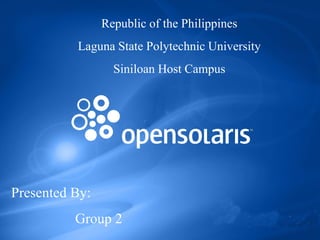
Open solaris (final)
- 1. Republic of the Philippines Laguna State Polytechnic University Siniloan Host Campus Presented By: Group 2
- 2. Introduction Special Feature Caiman Project Desktop Features Server Features Storage Features Virtualization History
- 3. OpenSolaris is an open source computer operating system based on Solaris created by Sun Microsystems, now a part of Oracle Corporation. It is also the name of the project initiated by Sun to build a developer and user community around the software. Introduction
- 4. OpenSolaris is a descendent of the UNIX System V Release 4 (SVR4) codebase developed by Sun and AT&T in the late 1980s. It is the only version of System V available as open source. OpenSolaris is developed as a combination of several software consolidations which were open sourced subsequent to Solaris 10. It includes a variety of free software, including popular desktop and server software. Sun has announced that future versions of its commercial Solaris operating system will be based on the OpenSolaris project. Main Menu
- 5. OpenSolaris is based on Solaris, which was originally released by Sun in 1991. Solaris is a version of UNIX System V Release 4 (SVR4), jointly developed by Sun and AT&T to merge features from several existing Unix systems. It was licensed by Sun from Novell to replace SunOS. History
- 6. Planning for OpenSolaris started in early 2004. A pilot program was formed in September 2004 with 18 non-Sun community members and ran for 9 months growing to 145 external participants. Sun submitted the CDDL (Common Development and Distribution License) to the OSI, which approved it on January 14, 2005.
- 7. The first part of the Solaris code base to be open sourced was the Solaris Dynamic Tracing facility (commonly known as DTrace), a tool that aids in the analysis, debugging, and tuning of applications and systems. DTrace was released under the CDDL on January 25, 2005 on the newly launched opensolaris.org website. The bulk of the Solaris system code was released on June 14, 2005. There remains some system code that is not open sourced, and is available only as pre-compiled binary files.
- 8. Initially, Sun's Solaris Express program provided a distribution based on the OpenSolaris code in combination with software found only in Solaris releases. The first independent distribution was released on June 17, 2005, and many others have emerged since.
- 9. On March 19, 2007, Sun announced that it had hired Ian Murdock, founder of Debian, to head Project Indiana , an effort to produce a complete OpenSolaris distribution, with GNOME and userland tools from GNU, plus a network-based package management system. The new distribution was planned to refresh the user experience, and would become the successor to Solaris Express as the basis for future releases of Solaris.
- 10. On May 5, 2008, OpenSolaris 2008.05 was released, in a format that could be booted as a Live CD or installed directly. It uses the GNOME desktop environment as the primary user interface. The later OpenSolaris 2008.11 release included a GUI for ZFS' snapshotting capabilities, known as Time Slider, that provides functionality similar to Mac OS X's Time Machine.
- 11. In December 2008 Sun Microsystems and Toshiba America Information Systems announced plans to distribute Toshiba laptops pre-installed with OpenSolaris. On April 1, 2009, the Tecra M10 and Portégé R600 came preinstalled with OpenSolaris 2008.11 release and several supplemental software packages.
- 12. On June 1, 2009, OpenSolaris 2009.06 was released, with support for the SPARC platform. On January 13, 2010, Sun discontinued the Solaris Express program to focus on the OpenSolaris distribution. Main Menu
- 13. The OpenSolaris Caiman Project has been delivering innovations in installation technology to OpenSolaris for over a year. The effort will result in a completely rebuilt installation experience for users, developers, and administrators. Special Feature
- 14. Three new Caiman features being developed include the ability to create and distribute a customized x86 virtual machine, support for creating auto install (AI) media that can be booted directly to initiate an automated installation, and support for a text installer.
- 15. The Virtual Machine Constructor project will design and implement a constructor which will, in a 'hands-off' manner, generate a preconfigured and preinstalled virtual machine. While we're primarily targeting VirtualBox for the constructed image we should be able to support other hypervisors that support the Open Virtual Machine Format which is what we'll use for the constructed images. The VM constructor essentially creates a new image type for the Distribution Constructor to output in addition to the current LiveCD and AI images. Main Menu